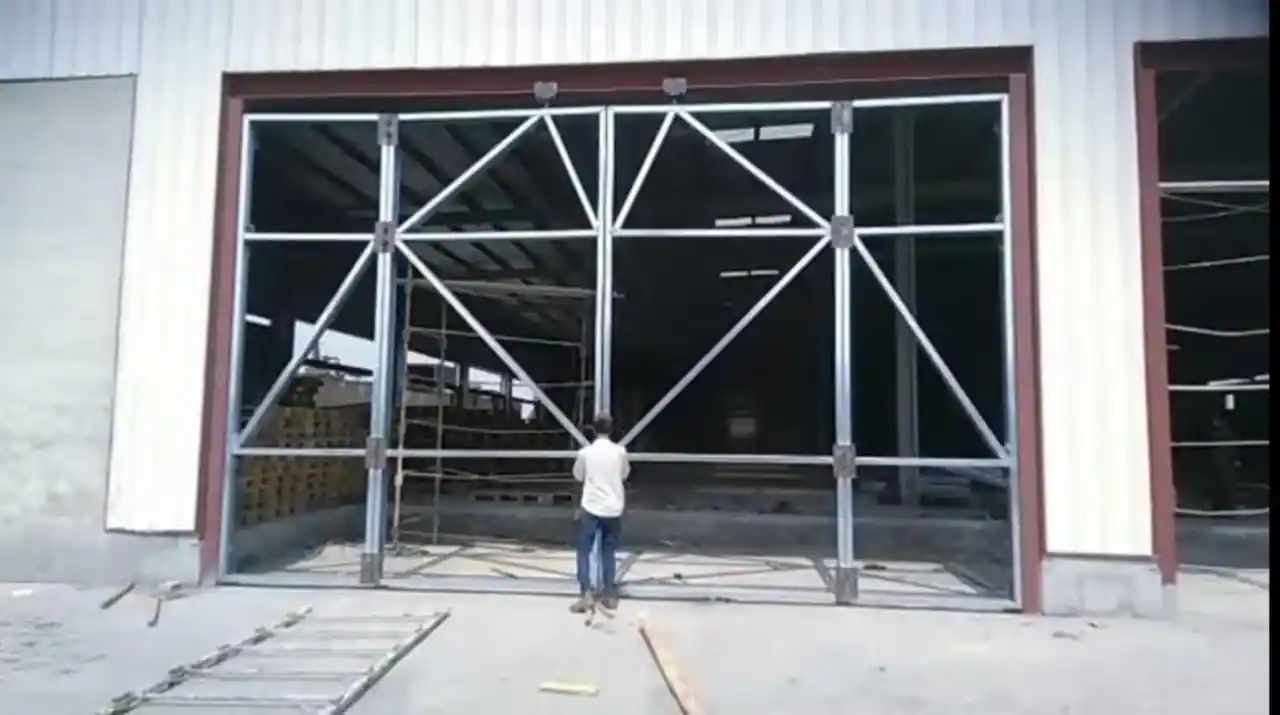Warehouse Door Insulation is as important as garage door insulation. Along with this, we have shared information about Warehouse Roof Insulation, and Warehouse Wall Insulation, now here in this post you will get detailed information about Warehouse Door Insulation. Insulated warehouse doors can increase the energy efficiency of the warehouse and protect all things stored in the warehouse. There is a variety of door types available in the market, you may read the information about all the types of doors / Types of Garage Doors in this post.
You understand how crucial it is to keep the temperature inside your building constant if you own a warehouse or industrial building. The warehouse door is a crucial component of temperature regulation that is frequently disregarded. In reality, the door may be a considerable source of heat input or loss, particularly if it is improperly insulated. You may lower energy expenditures, create a more comfortable working atmosphere, and even lengthen the HVAC system’s lifespan by insulating your warehouse door. We’ll examine the advantages of warehouse door insulation in this blog post.
After installing, warehouse door insulation you will get more benefits such as increased energy efficiency, improve productivity, provide security from fire, heat, and water, helping to make a better working place, and providing you peace of mind. This is the basic benefit of an insulated door warehouse in short, let’s see all information in brief, so continue with reading.
Benefits of door insulation to warehouse
Let’s try to understand which benefits you will get after insulating the warehouse door, and Why Should Your Warehouse Door Be Insulated? Your warehouse door should be insulated for several good reasons and make beneficial to you like-
Reduce Energy Costs
An uninsulated door can let the hot or cold air escape, making your HVAC system work harder to keep the temperature steady. Insulating your door will help you use less energy to heat or cool your building, which will eventually result in significant financial savings. sdvfeef
Maintain a Comfortable Workplace
In industrial settings, workers are routinely exposed to oppressive heat, which can impair focus and productivity, and mostly warehouse construction for industrial working space. For main By insulating your door, you may make your office more comfortable, which can raise spirits and increase output.
How to Insulate Door/How to Insulate Door of The Warehouse
If you want to insulate the warehouse door with an insulation kit, we suggest you, use Owens Corning Garage Door Insulation Kit, available on Amazon. You can insulate the warehouse door by using this kit, step-by-step

- Clean up the warehouse door. Remove any dirt or debris from the door surface that could obstruct the insulation process by cleaning it.
- Open the kit and then lay out the item according to the size of the door.
- The quantity of insulation material needed will depend on the door’s dimensions.
- Measure the door’s dimensions to determine how much insulation material is required.
- Then mark it on clips. The insulation material must be precisely shaped and sized to fit the door. To prevent squeezing the insulation, allow a tiny space around the edges.
- Trim the screws. The insulation material must be precisely shaped and sized to fit the door. To prevent squeezing the insulation, allow a tiny space around the edges.
- Add the adhesive and clips.
- Add the insulation. Folden the insulation to the door using glue, staples, or screws. The procedure will depend on the type of door and the insulation utilized.
- Add the foil tape to the gaps. By looking for leaks or draughts, you can evaluate the insulation. Adjust the insulation or sealing as necessary if any problems are identified. (Nashua 322 Multipurpose Foil Tape, 3.2 mil Thick, 9 m Length, 48mm Width, Aluminium) available on Amazon.
- Fill up any openings or cracks at the door’s edges to stop air leaks. Caulk or weatherstripping can be used for this.

You can insulate your warehouse door properly by using these tips, and increase energy efficiency, as well as lower heating and cooling costs by adhering to these instructions. we hope these tips will like and help you
The following advice will help you to get started if you’re prepared to insulate your warehouse door, it will be helpful to you:
Select the Proper Insulation Material
You know a variety of insulation materials are available, including fiberglass, foam, and reflective foil. Pick a material based on your needs and financial constraint as well as the area of your warehouse
measure the size of the door
Before you begin insulating, make it essential to thoroughly measure your door to make sure you get adequate insulation material. For the insulation to be cut to the proper size according to the door of the warehouse, you must also know the accurate size of your door.
Check the r-value of material
You may know the importance of r value.
You know that in the market so many variety doors are available for industrial buildings like garage or warehouse, but in the rush of all that many warehouse owners use Roll Up Door for warehouse and every constructor recommend using this type of door for warehouse so here we are sharing all information about this type of warehouse doors.
Warehouse Roll Up Door Insulation/ Best Door Insulation
There are several advantages to insulating a roll-up door in a warehouse. In addition to providing some sound insulation to help keep noise levels low, it can assist the structure become more energy efficient by lowering heat gain or loss. The style of the door, the local temperature, and the available budget are just a few of the variables that will determine the optimum door insulation for a warehouse. A warehouse may benefit from the following popular door insulation types:
A warehouse roll-up door may be equipped with a variety of insulation kinds, such as:
Fiberglass Insulation – Warehouse Door Insulation
Insulation comprised of glass fibers is called fiberglass and is a common type of insulation. It is frequently used for doors, walls, and ceilings and can be put in batt or blown-in form. A cheap alternative that works with many different types of doors is fiberglass insulation. In addition to offering strong thermal insulation, installation is rather simple. This insulation is good for insulating the warehouse door. It can provide you with thermal efficiency and will help a little bit with sound reduction.
Foam insulation – Best Door Insulation
You may know that foam insulation is available in 2 types of insulation methods either foam board or spray foam. So, you can use either polyurethane foam board insulation or polystyrene foam insulation to create an excellent insulator for the warehouse door, it is best door insulation. this form of insulation. Both stiff panels and spray application on the door are known as great options.
Due to its superior thermal as well as acoustic insulation its famous for insulating warehouse doors, this kind of insulation is frequently used in metal doors. Foam insulation is great and a solid barrier against air and noise intrusion is made by injecting polyurethane foam into the hollow core of the door, filling the whole cavity, and making a properly insulated door for the warehouse.

Reflective Insulation – Best Door Insulation
Insulation that reflects light: This kind of insulation is constructed of an aluminum foil layer that is backed by an insulation layer. It may be put in either on the inside or outside of the door and is made to reflect heat.
It is crucial to take into account elements like the R-value (a metric for determining how efficient the insulation is), cost, and simplicity of installation when selecting an insulation material. Additionally, it’s crucial to make sure the insulation material doesn’t obstruct how the roll-up door operates.
Polyurethane Insulation – warehouse door insulation
The doors of warehouses are frequently insulated with polyurethane material. High-density polyurethane foam insulation offers and delivers exceptional insulating performance. Although this insulation is more expensive than alternative insulation options, it is typically a good choice for large warehouse doors that must withstand severe weather.
Along with all this, you may use another best tool and technique of insulation that is weatherstripping, it makes your warehouse doors proper and accurately insulated and increases the energy efficiency of your warehouse doors. Let’s see detailed information about it in the next passage.
Weatherstripping – Warehouse Roll Up Door Insulation
Although weatherstripping is not specifically a sort of insulation, it can be a useful tool for caulking gaps around warehouse doors to keep out air penetration and make solid insulation. A door frame or the bottom of the door may be covered with weatherstripping, which is frequently composed of foam, rubber, or vinyl. This tool is known as the best for making properly insulated warehouse doors.
It is advised to seek advice from a qualified builder or insulation installer to choose the ideal insulation approach for your particular warehouse roll-up door.
At The End of, Warehouse Door Insulation and how to insulate door
In the end, your unique requirements and financial situation will determine which door insulation is ideal for your warehouse. To achieve great insulation quality inside the warehouse you talk with an industrial door installer and establish the best course of action for your circumstance, it could be a good idea to speak with a qualified insulation contractor.
What is the best insulation for doors?

There are various efficient options available for insulating doors. The type of door, where it is located, and the particular insulation requirements all play a role in determining the optimal insulation for doors. Here are some typical door-insulating materials:
1. Weatherstripping:
Although it’s not a typical insulation material, weatherstripping is essential for plugging gaps and halting air leaks around doors. It comprises seals or strips composed of vinyl, foam, or rubber. The improvement of energy efficiency and the elimination of draughts are two areas where weatherstripping excels.
2. Door Sweeps:
To close the space between a door and a threshold, flexible strips of material are placed on the bottom of a door. They add to the insulation’s effectiveness and weather protection by blocking out noise, dust, insects, and draughts.
3. Foam Tape:
Foam tape is an inexpensive and simple-to-install method for insulating doors. It normally comes in rolls with an adhesive backing, allowing for easy application to the door frame or around the door’s edges to form a tight seal.
4. Fibreglass or Foam Insulation:
To enhance the insulating capabilities of solid doors, fiberglass or foam insulation can be applied to the door’s core. Depending on the type of door, this option can need professional installation or door replacement.
These are the best insulation for warehouses or any kind of commercial building. You may select anyone from them.
How do you insulate a shop door?

Insulating a shop door can help to stop the entrance noise, maintain temperature control, and increase energy efficiency. Here are the procedures for insulating a storefront door:
Clean up the warehouse door. Remove any dirt or debris from the door surface that could obstruct the insulation process by cleaning it.
1. Open the kit and then lay out the item according to the size of the door.
The quantity of insulation material needed will depend on the door’s dimensions.
2. Measure the door’s dimensions to determine how much insulation material is required.
Then mark it on clips. The insulation material must be precisely shaped and sized to fit the door. To prevent squeezing the insulation, allow a tiny space around the edges.
3. Trim the screws. The insulation material must be precisely shaped and sized to fit the door. To prevent squeezing the insulation, allow a tiny space around the edges.
4. Add the adhesive and clips.
5. Add the insulation. Folden the insulation to the door using glue, staples, or screws. The procedure will depend on the type of door and the insulation utilized.
6. Add the foil tape to the gaps. By looking for leaks or draughts, you can evaluate the insulation. Adjust the insulation or sealing as necessary if any problems are identified.
7. Fill up any openings or cracks at the door’s edges to stop air leaks. Caulk or weatherstripping can be used for this.
Do let us know how you feel about this information by commenting.
Like our Facebook page and follow for other updates like this.

